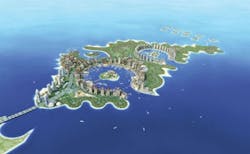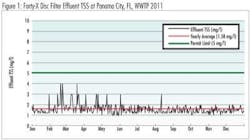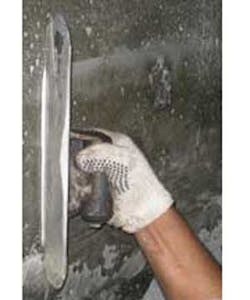By Joey Herndon
Panama City Beach is situated on 27 miles of white-sand beaches where the Gulf of Mexico and St. Andrew Bay converge in the panhandle of Northwest Florida. One of the country's most popular travel destinations, it is populated by approximately 13,000 permanent residents and welcomes more than six million visitors each year. On average, Panama City Beach experiences an 8% annual growth rate.
The city is ecologically significant in that it is surrounded by thousands of acres of protected wetlands which are part of the West Bay Ecosystem. Due to decades of extensive tree farming, the natural water balance of the wetlands had been negatively altered.
Eleven years ago, Panama City Beach leaders were charged with devising a long-range plan that would accomplish distinct but related goals: first, redirect wastewater from the local Advanced Wastewater Plant away from the ecosystem; then, increase the capacity of the plant to accommodate the increasing population of Panama City Beach; and finally, put the reclaimed water from the expanded plant to beneficial use by re-hydrating the ecosystem with it.
In addition to city and water officials, the Florida Department of Environmental Protection, the Corps of Engineers and the Florida Department of Fish and Wildlife were involved in developing an appropriate course of action, a more than decade-long process that came to fruition in various stages.
Plant Expansion
City and water officials determined that increasing the capacity of the Advanced Wastewater Plant to 14 mgd from the current 10 mgd was the appropriate rate of expansion to meet both the immediate and long-term needs of the community. The size and scale of the project, and the accompanying expenditures, were immense, from the acquisition of new real estate to construction costs to the purchase and installation of new equipment, processes and systems.
The city contracted with local consulting engineering firm Baskerville Donovan to design the project. An employee from the company had previously attended a Siemens Water Academy training session where he learned about the Forty-X™ Disc Filter and how it can be retrofitted into an existing Traveling Bridge Filter (TBF) to increase capacity. Since the Advanced Wastewater Plant already had a Gravisand® TBF in operation from a prior installation, the employee contacted the southeast regional team of Siemens Water Technologies to learn more about the disc filter retrofit option.
The base bid called for the addition of another TBF, which would require a greater footprint and a new poured-in-place concrete tank. Instead, Siemens recommended installing four disc filter units, which have a flexible operating hydraulic profile that would allow them to be retrofitted into the existing filter tank. In addition to preserving valuable real estate and saving Panama City Beach tens of thousands of dollars in construction costs by using existing piping and concrete tankage, the installation of the disc filters would increase filtration capacity to 10 mgd in half the space that previously had provided only 4.5 mgd.
The consulting engineer was presented with two equipment layout options. The one selected used less than half of the 100-foot-long TBF concrete tank that was already in place and allowed the new filters to use the existing influent and effluent channels with limited modifications. In addition, Siemens proposed using stainless steel bulkheads versus concrete walls to separate the units for isolation purposes, which reduced construction costs.
The system was designed using influent data supplied by the consulting engineer and the plant. The disc filter system design called for four, 12-disc units, each with a capacity of 2.5 mgd.
Turnkey Project
The selected equipment layout option was written into the specification as an alternate to the new TBF base bid and in November 2009 Siemens bid the package as a turnkey project. When general and mechanical contracting firm Adams Robinson Enterprises was awarded the project, it partnered with Siemens for the filtration retrofit portion.
"We contracted with Siemens for the demolition of the existing TBF, the modification of the existing concrete tankage and the supply, installation and commissioning of the new Forty-X Disc Filter equipment," said Thomas M. Jobe, P.E., Vice President-Project Management at Adams Robinson. "We worked together to coordinate all construction activities in a manner that allowed the plant to remain operational during the expansion."
Siemens field crews, based in Thomasville, GA, arrived on the job site September 6, 2010. Their first order of business was to coordinate with the contractor and plant operators on the isolation of the TBF so dismantling of the mechanical equipment could get underway. At the same time, the new disc filters were being assembled and readied for shipment at the Thomasville manufacturing facility. They arrived on site September 23, 2010, and were off-loaded and staged for installation into the existing TBF basin. The retrofit process was completed on November 12, 2010 – the demolition of the TBF, the modification to the concrete TBF tankage and the installation of the disc filters took less than 10 weeks.
The entire project was completed in February 2011 and the new filter system was commissioned on the 25th of that month.
Performance
The retrofit produced immediate results. The reduced TSS and NTU measurements fell well below permit requirements. Additionally, the backwash return to the plant was reduced to 1% of the total flow to the disc filters. This had a direct positive impact on the plant because the TBFs that were retrofitted returned up to 5% of the total flow back to the head works.
Today, the Advanced Wastewater Plant in Panama City Beach has the capacity to pump up to 14 mgd of treated wastewater through an elaborate piping system in the West Bay Ecosystem, a 2,900-acre site recently renamed Conservation Park and officially opened in the fall of 2011.
A 36-inch diameter main transmission pipe carries the reclaimed effluent five miles to the park, where the pipe divides into four different, smaller pipes, each of which coincides with a different area. These areas receive water on a rotated cycle that keeps the wetlands hydrated at different growing seasons throughout the year. In total, there are 14.5 miles of new pipe carrying the excess reuse water onto the new site, where it discharges from box-like structures tucked into the woods that surround the park.
The water filters though the landscape, mimicking the natural flow of rainwater, on its way to the Intracoastal Waterway. With minor additions, the system will ultimately be able to pump up to 18 mgd to accommodate future population increases in Panama City Beach.
The expansion of the Advanced Wastewater Plant, the upgrades to it and the redirection of effluent have resulted in several significant benefits for the ecosystem within Conservation Park. In addition to protecting the water quality of the wetlands and restoring its altered hydrology to a natural state, the habitat of native species that live within the ecosystem has been restored. Residents and visitors can take advantage of the park's eight boardwalks that total more than one mile in length and 24 miles of bike and hiking trails.
"The plant expansion and wetlands discharge has made it possible to start the process of restoring the wetlands to its original status while providing an excellent area for the public to learn about Florida's diverse wildlife," said Advanced Wastewater Plant Superintendent Kevin Aclin.
About the Author: Joey Herndon is a Sales Manager with Siemens Water Technologies. Based in Thomasville, GA, he contacted via email at [email protected].
More WaterWorld Current Issue Articles
More WaterWorld Archives Issue Articles






